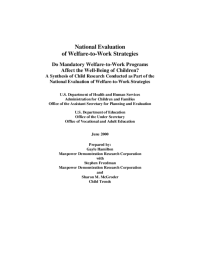Do Mandatory Welfare-to-Work Programs Affect the Well-Being of Children?
A Synthesis of Child Research Conducted as Part of the National Evaluation of Welfare-to-Work Strategies
This document examines the effects of welfare-to-work programs on the children of the adults (almost all single mothers) mandated to participate in such programs. Synthesizing the results from two recently completed reports from a large-scale evaluation — the National Evaluation of Welfare-to-Work Strategies (NEWWS Evaluation) — the two-year effects of 11 welfare-to-work programs that operated in seven sites in the early to mid 1990s are summarized. The sites included in the evaluation are Atlanta, Georgia; Columbus, Ohio; Detroit and Grand Rapids, Michigan; Oklahoma City, Oklahoma; Portland, Oregon; and Riverside, California. While the programs operated under the federal Job Opportunities and Basic Skills Training (JOBS) program that preceded TANF, and thus did not invoke a time limit on eligibility for welfare, they shared TANF’s primary goal of moving welfare recipients into paid work and off assistance, and they reflect a range of approaches, implementation features, and environments: Some were strongly employment-focused while others emphasized basic education; they varied in how broadly the program participation mandate was applied to the welfare caseload and how strictly it was enforced, in the amount of child care support provided for program participation or employment, and in methods of case management; and the programs served different welfare populations and operated in a variety of labor markets. Although the NEWWS evaluation was designed to address the effects on children of requiring parents to participate in welfare-to-work programs, there are many other policies — for example, child care and health insurance policies — that can affect children, and those policies can be examined only indirectly in this evaluation.






